Numerical Analysis of the Load-Bearing Capacity of a Thin-Walled Perforated Beam Cooperating with Chipboard Panels in a Structural System
Abstract
1. Introduction
2. Materials and Methods
- Testing a structural system with a span of 3 m, loaded linearly over a length of 1 m;
- Testing a structural system with a span of 6 m, loaded linearly over a length of 1 m;
- Determining the mechanical properties of the steel used for beams and connectors.
- Creation and validation of numerical models reflecting the tested 3-m span structural system;
- Development and validation of numerical models corresponding to the 6-m span structural system;
- Preparation of numerical models for structures with spans ranging from 3.0 m to 6.0 m (at intervals of 0.5 m), subjected to uniformly distributed loads along their entire lengths;
- Execution of numerical simulations to establish load-bearing capacity curves.
2.1. Laboratory Tests
- Loading phase: achieving actuator displacement of 7.0 mm within 70 s for the 3 m beam and 15.0 mm within 150 s for the 6 m beams (speed 0.1 mm/s);
- Unloading phase: returning actuator displacement to 0.0 mm within 70 s for the 3 m beam and 150 s for the 6 m beams (speed 0.1 mm/s);
- Elastic testing phase: increasing actuator displacement again from 0.0 mm to the respective maximum displacement values (7.0 mm for the 3 m beam, 15.0 mm for the 6 m beams) while recording displacements and forces to plot deflection-force diagrams;
- Destructive testing phase: after elastic tests, beams were unloaded to an actuator displacement of 0.0 mm, then reloaded until structural failure occurred at a rate of 0.1 mm/s, with deflection–force diagrams recorded throughout.
- Initial loading: achieving actuator displacement of 0.3 mm within 60 s (speed 0.3 mm/min);
- Unloading: returning actuator displacement to 0.0 mm within 60 s (speed 0.3 mm/min);
- Main loading phase: increasing actuator displacement from 0.0 mm to 0.3 mm over 60 s (speed 0.3 mm/min), during which elongation and force measurements were continuously recorded, resulting in force-elongation diagrams.
2.2. Numerical Model
- 3 m span: 46,558 elements;
- 6 m span: 71,387 elements.
- Connectors were rigidly fixed at the mounting hole locations, with a contact surface diameter of 40 mm.
- A “tie” contact [23] was applied between the connectors and beams, ensuring a fully constrained (rigid) connection.
- Symmetric boundary conditions were imposed along the system’s axis of symmetry, affecting both the chipboard and beams.
- Normal behavior; “hard” contact.
- Tangential behavior: Penalty method with a friction coefficient of 0.3.
- Young’s modulus E = 205 GPa (determined from laboratory tests).
- Poisson’s ratio ν = 0.3.
- Yield strength RH = 457 MPa (determined from laboratory tests).
- Young’s modulus E = 191 GPa (determined from laboratory tests).
- Poisson’s ratio ν = 0.3.
- Yield strength RH = 362 MPa (determined from laboratory tests).
- Young’s modulus E = 2100 MPa, manufacturer’s data.
- Poisson’s ratio ν = 0.3.
- Yield strength RH = 7.5 MPa, manufacturer’s data.
- Young’s modulus E = 3100 MPa, manufacturer’s data.
- Poisson’s ratio ν = 0.3.
- Yield strength RH = 11.7 MPa, manufacturer’s data.
2.3. Numerical Model for Developing Load-Bearing Curves of the Central Beam
3. Results and Discussion
3.1. Results of Laboratory Tests
3.2. Results of Numerical Simulations and Model Validation
- For the 3 m beam, the loss of load-bearing capacity occurs due to material plasticization in the central zone of the beam (highlighted in red), as well as at the connection points between the connector and the beam, and within the connector itself. Additionally, failure is contributed to by the fracture of the deck panel.
- For the 6 m beam, a different failure mode is observed. The beam does not exhibit plasticization in either the central or support zones. Instead, the dominant failure mechanism is the fracture of the deck panel (highlighted in red), indicating exhaustion of its bending capacity.
- In both cases (3 m and 6 m beams), connector plasticization is consistently observed, which aligns with the experimental test results.
- Qualitative validation involved assessing whether the structural system’s behavior in the numerical simulations was consistent with the experimental observations.
- During elastic-range testing, horizontal displacements were recorded at various measurement points, as shown in Figure 2.
- The graphs were generated using average values from all experimental tests conducted within the elastic range of beam behavior and were compared with the results obtained from the numerical model.

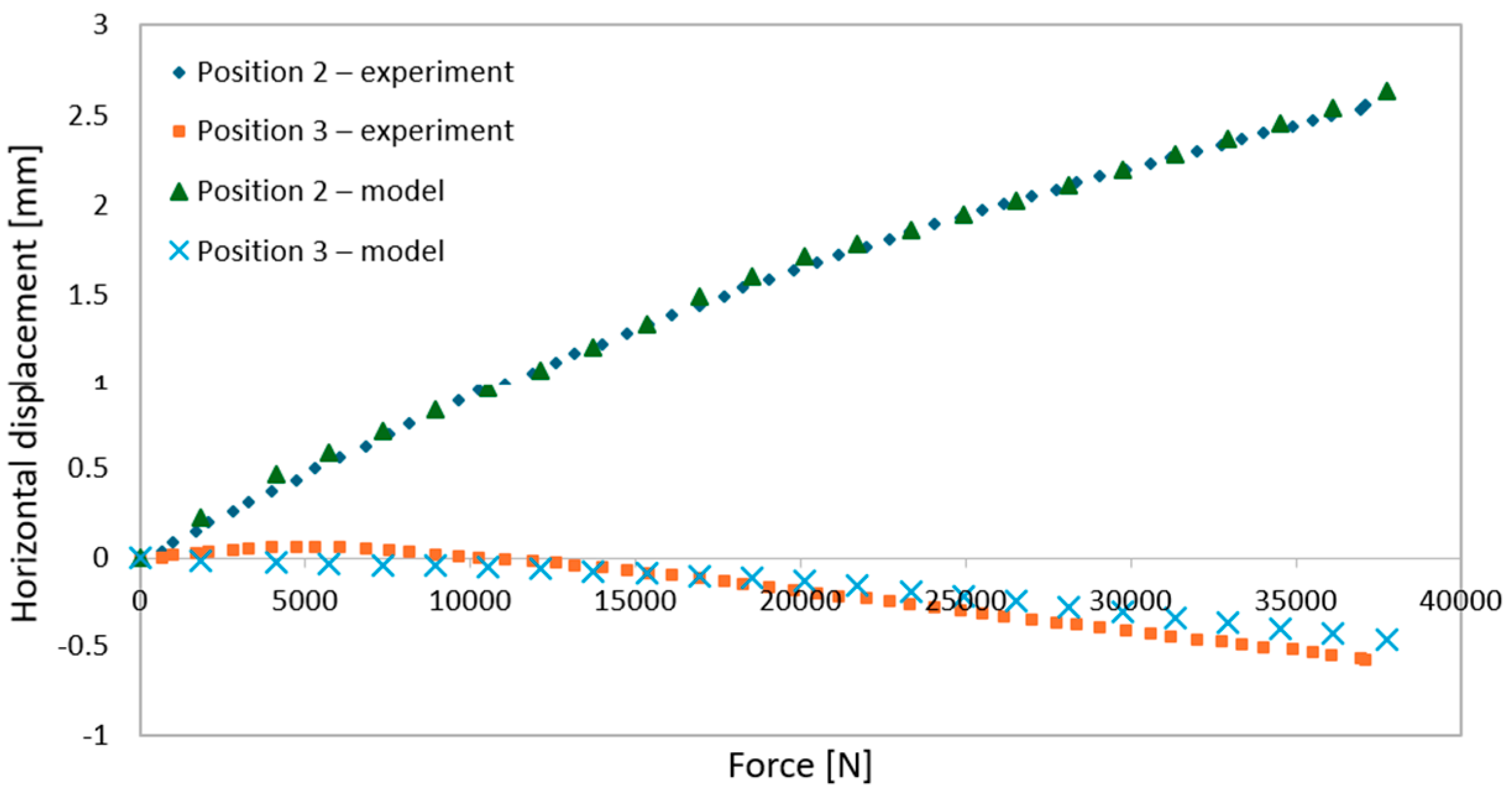
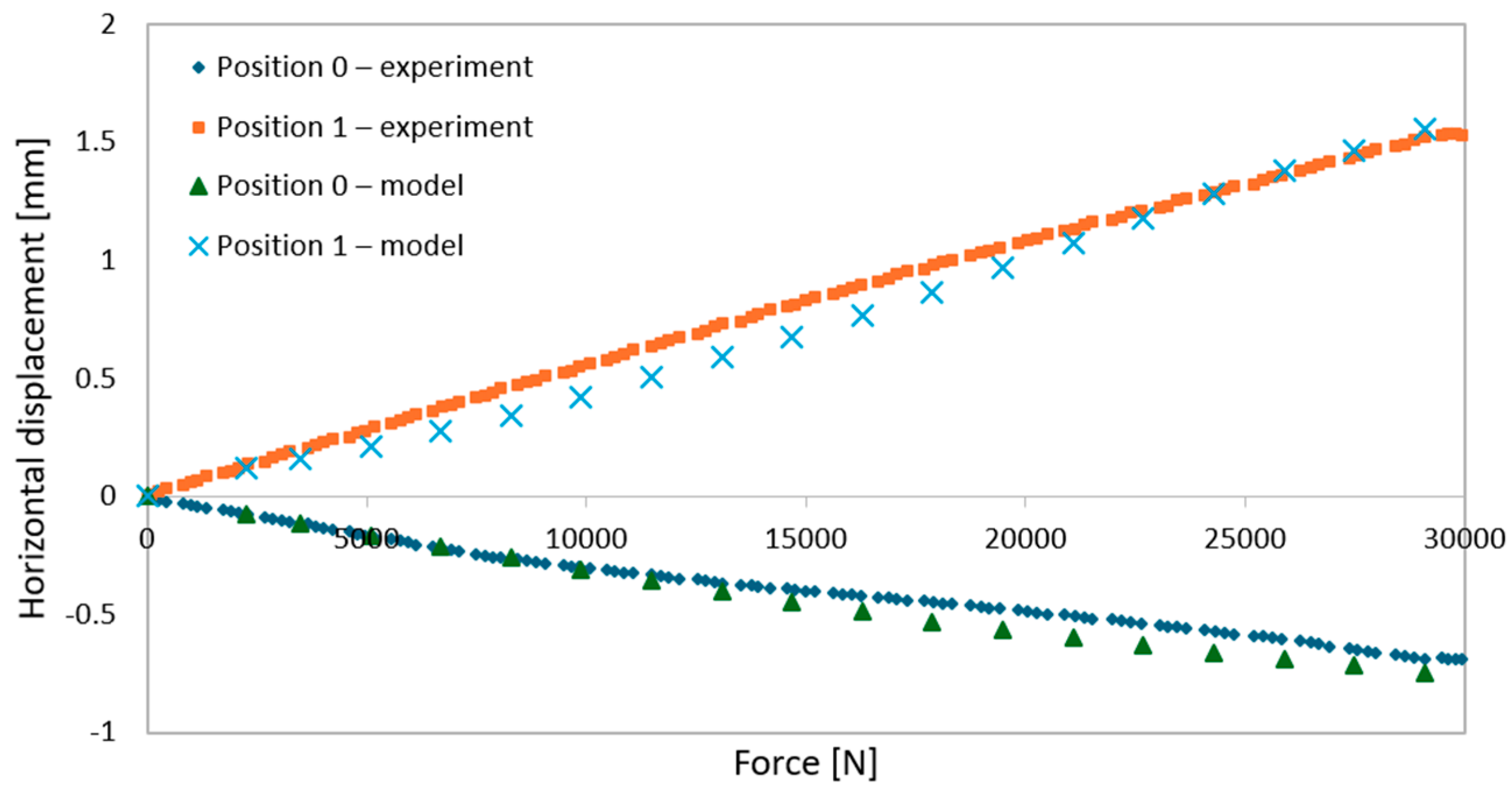
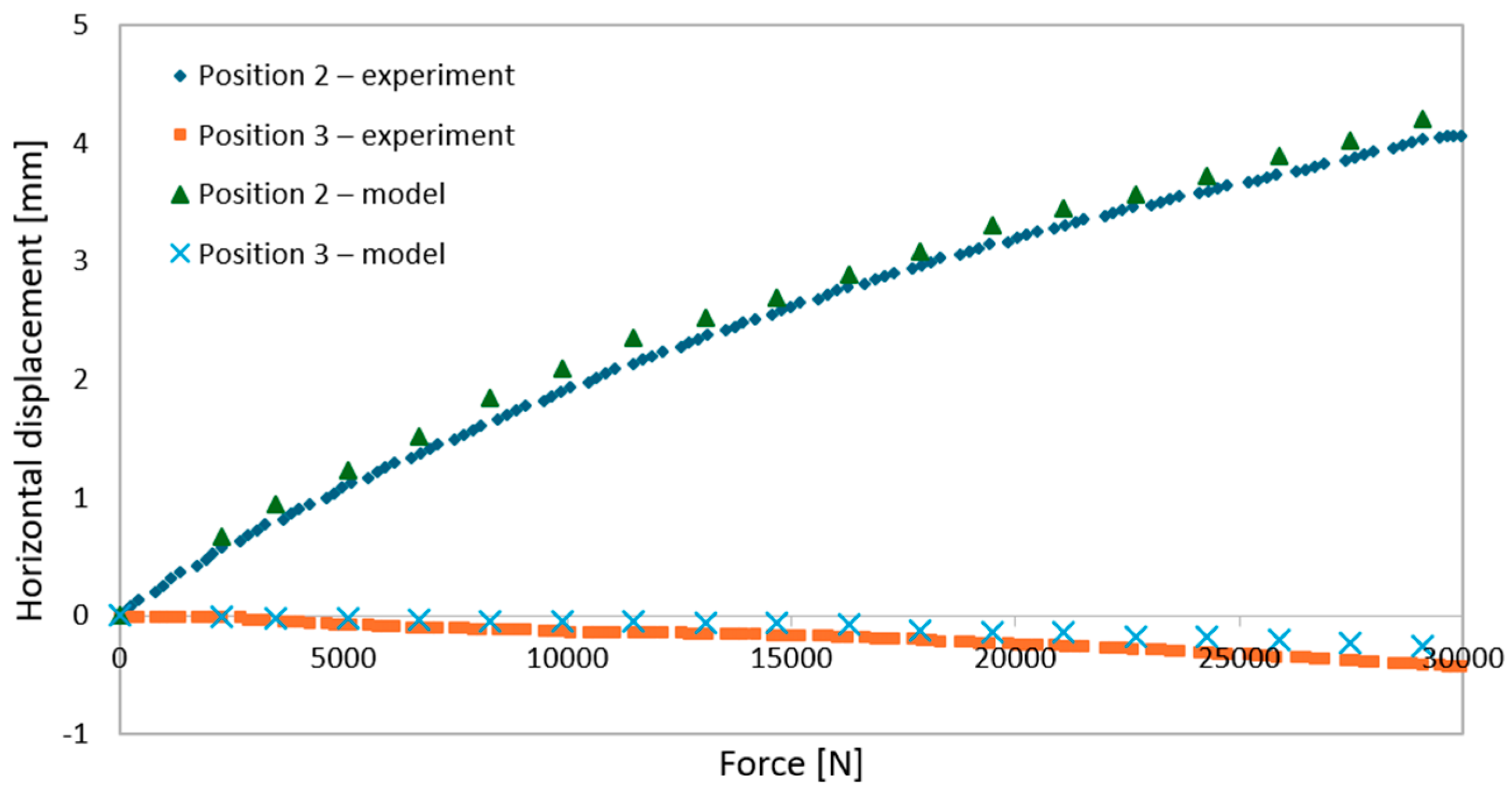

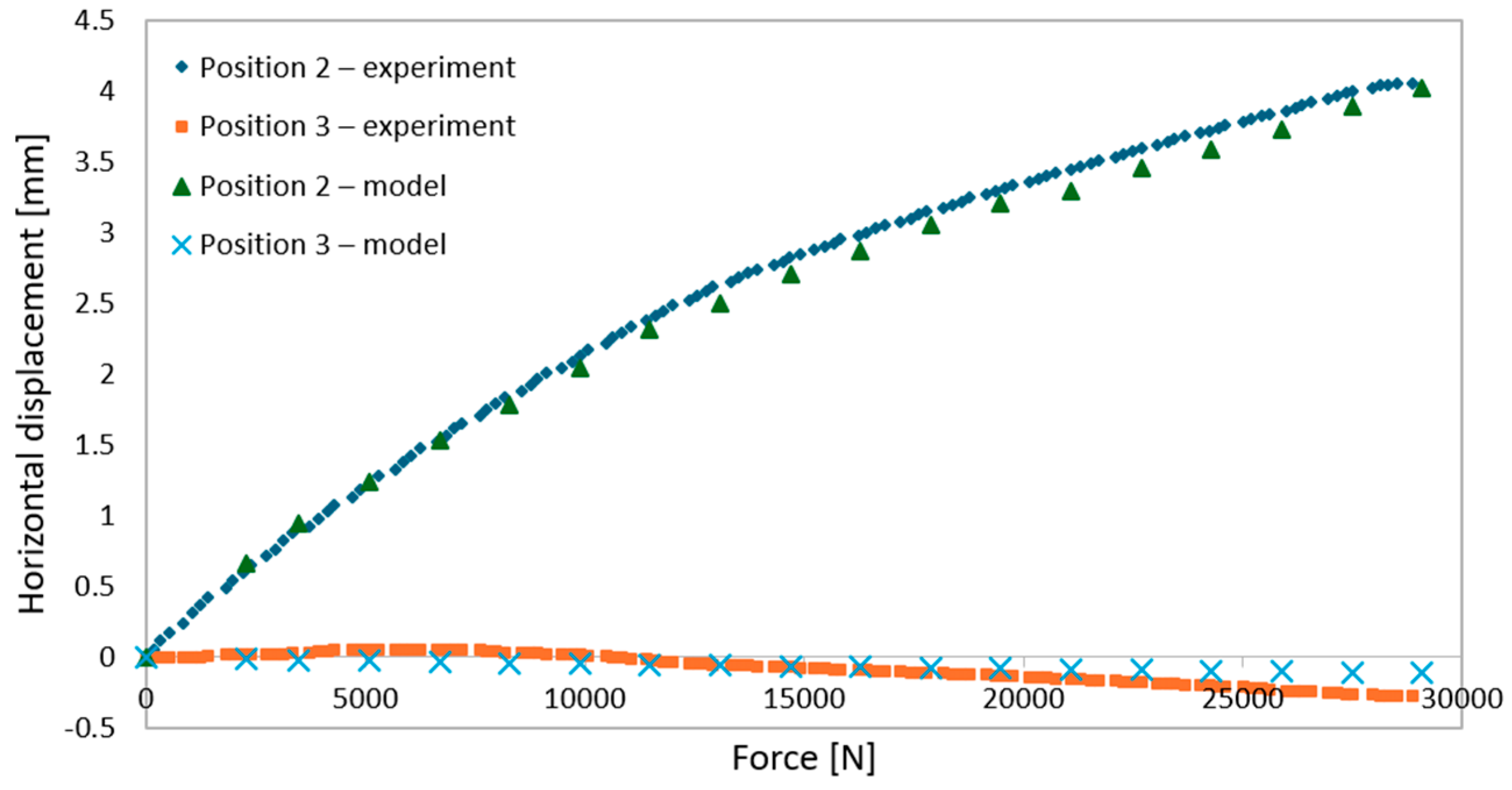
3.3. Numerical Simulations of the Analyzed System over the Full Span Range
- The limit values for deflection at the mid-span of the central beam were set at L/250 or L/350 as the load-bearing capacity exhaustion threshold.
- Since laboratory tests and numerical simulations identified the connector as the weakest element in the system, an additional failure criterion was established: reaching 5% LE Max. Principal (Abs) 19 in the connector.
- LE Max. Principal (Abs) represents a logarithmic strain measure, useful in nonlinear analyses where small-strain assumptions are insufficient.
- Young’s modulus: E = 200 GPa
- Poisson’s ratio: ν = 0.3
- Yield strength: RH = 350 MPa
- Young’s modulus: E = 200 GPa
- Poisson’s ratio: ν = 0.3
- Yield strength: RH = 235 MPa
- Young’s modulus: E = 2100 MPa (manufacturer’s data)
- Poisson’s ratio: ν = 0.3
- Yield strength: RH = 7.5 MPa (manufacturer’s data)
- L/250—This criterion corresponds to the allowable deflection relative to the beam span and is commonly used in general construction as a serviceability limit to ensure acceptable deformation levels.
- L/350—A more conservative deflection limit than L/250, applied in cases requiring increased stiffness and stricter serviceability conditions, such as in structures with sensitive finishes or precision equipment.
- 5%. LE Max. Principal (Abs) in the connector—This limit indicates the onset of plastic deformation in the connector, marking a critical stage at which the component begins to yield and lose its elastic behavior under load.
- 5%. LE Max. Principal (Abs) in the beam—This criterion defines the point at which the beam itself begins to plastify, signaling a transition from elastic to plastic behavior and providing a reference for ultimate load-bearing capacity.
4. Conclusions
- Failure mechanisms depend on span length. In 3 m beams, plasticization in the central zone occurred nearly simultaneously with deck panel fracture, indicating strong composite interaction. For 6 m spans, deck fracture preceded beam yielding, reflecting reduced structural synergy due to higher deflections and stress.
- Consistent results across simulations and experiments. The model accurately reproduced the initiation and development of failure, confirming its predictive capability.
- Horizontal displacement patterns. Significant lateral displacements occurred consistently in the lower flange, as the upper flange was stiffened by the chipboard. To mitigate this, additional reinforcement or bracing between the bottom flanges is recommended, although not yet modeled.
- Identification of critical elements. The connectors and support zones were found to be the weakest components. In all configurations, failure began with connector plasticization, regardless of span.
Author Contributions
Funding
Institutional Review Board Statement
Informed Consent Statement
Data Availability Statement
Conflicts of Interest
References
- Cheng, Y.; Schafer, B.W. Distortional buckling test on cold-formed beams. J. Struct. Eng. 2005, 132, 515–528. [Google Scholar]
- Tsavdaridis, K.D.; Kingman, J.J.; Toropov, V.V. Application of structural topology optimisation to perforated steel beams. Comput. Struct. 2015, 158, 108–123. [Google Scholar]
- American Iron and Steel Institute. Specification for the Design of Light Gage Steel Structural Members; American Iron and Steel Institute: Washington, DC, USA, 1946. [Google Scholar]
- EN 1993-1-3; Eurocode 3: Design of Steel Structures—Part 1–3: General Rules—Supplementary Rules for Cold-Formed Members and Sheeting. European Committee for Standardization: Brussels, Belgium, 2006.
- Taranu, G.; Toma, I.-O. Experimental investigation and numerical simulation of c-shape thin-walled steel profile joints. Buildings 2021, 11, 636. [Google Scholar] [CrossRef]
- Yu, W.-W.; LaBoube, R.A.; Chen, H. Cold-Formed Steel Design; John Wiley & Sons: Hoboken, NJ, USA, 2019. [Google Scholar]
- Blandford, G.E. Current research on cold-formed steel structures. In Proceedings of the 10th International Specialty Conference on Cold-Formed Steel Structures, St. Louis, MO, USA, 23–24 October 1990; Missouri University of Science and Technology: St. Louis, MO, USA, 1990. [Google Scholar]
- Lechner, B.; Pircher, M. Analysis of imperfection measurements of structural members. Thin-Walled Struct. 2005, 43, 351–374. [Google Scholar] [CrossRef]
- Amouzegar, H.; Amirzadeh, B.; Zhao, X.; Schafer, B.; Tootkaboni, M. Statistical analysis of the impact of imperfection modes on collapse behavior of cold-formed steel members. In Proceedings of the Annual Stability Conference Structural Stability Research Council, Nashville, TN, USA, 24–27 March 2015. [Google Scholar]
- Farzanian, S.; Louhghalam, A.; Schafer, B.; Tootkaboni, M. Geometric imperfection models for cfs structural members, part i: Comparative review of current models. Thin-Walled Struct. 2019, 186, 110619. [Google Scholar] [CrossRef]
- American Iron and Steel Institute (AISI). North American Standard for Cold-Formed Steel Structural Framing; American Iron and Steel Institute: Washington, DC, USA, 2015. [Google Scholar]
- GB 50017-2017; Code for Design of Steel Structures. China Architecture Building Press: Beijing, China, 2017.
- Goncalves, R.; Dinis, P.; Camotim, D. Gbt formulation to analyse the first-order and buckling behaviour of thin-walled members with arbitrary cross-sections. Thin-Walled Struct. 2009, 47, 583–600. [Google Scholar] [CrossRef]
- Goncalves, R.; Camotim, D. Generalised beam theory-based finite elements for elastoplastic thin-walled metal members. Thin-Walled Struct. 2011, 49, 1237–1245. [Google Scholar] [CrossRef]
- Abambres, M.; Camotim, D.; Silvestre, N. Modal decomposition of thin-walled member collapse mechanisms. Thin-Walled Struct. 2014, 74, 269–291. [Google Scholar] [CrossRef]
- Duan, L.; Zhao, J.; Liu, S. A b-splines based nonlinear gbt formulation for elastoplastic analysis of prismatic thin-walled members. Eng. Struct. 2016, 110, 325–346. [Google Scholar] [CrossRef]
- Hancock, G.J.; Pham, C.H. Buckling analysis of thin-walled sections under localised loading using the semi-analytical finite strip method. Thin-Walled Struct. 2015, 86, 35–46. [Google Scholar] [CrossRef]
- Adany, S.; Joo, A.L.; Schafer, B.W. Buckling mode identification of thin-walled members by using cfsm base functions. Thin-Walled Struct. 2010, 48, 806–817. [Google Scholar] [CrossRef]
- Liu, T.C.H.; Chung, K.F.; Ko, A.C.H. Investigation on Vierendeel mechanism in steel beams with circular web openings. J. Constr. Steel Res. 2003, 57, 467–490. [Google Scholar]
- Wang, P.S.; Ma, Q.L.; Wang, X.F. Investigation of Vierendeel mechanism failure of castellated steel beams with fillet corner web openings. J. Constr. Steel Res. 2004, 74, 44–51. [Google Scholar] [CrossRef]
- Denisiewicz, A.; Socha, T.; Kula, K.; Macek, W.; Błażejewski, W.; Lesiuk, G. Numerical determination of the load-bearing capacity of a perforated thin-walled beam in a structural system with a steel grating. Appl. Sci. 2024, 14, 1505. [Google Scholar] [CrossRef]
- PN-EN ISO 6892-1:2020-05; Metals—Tensile Test—Part 1: Room Temperature Test Method. Polish Committee for Standardization: Warszawa, Poland, 2020.
- Dassault Systemes. Abaqus Analysis User’s Manual; Dassault Systemes: Tokyo, Japan, 2022. [Google Scholar]


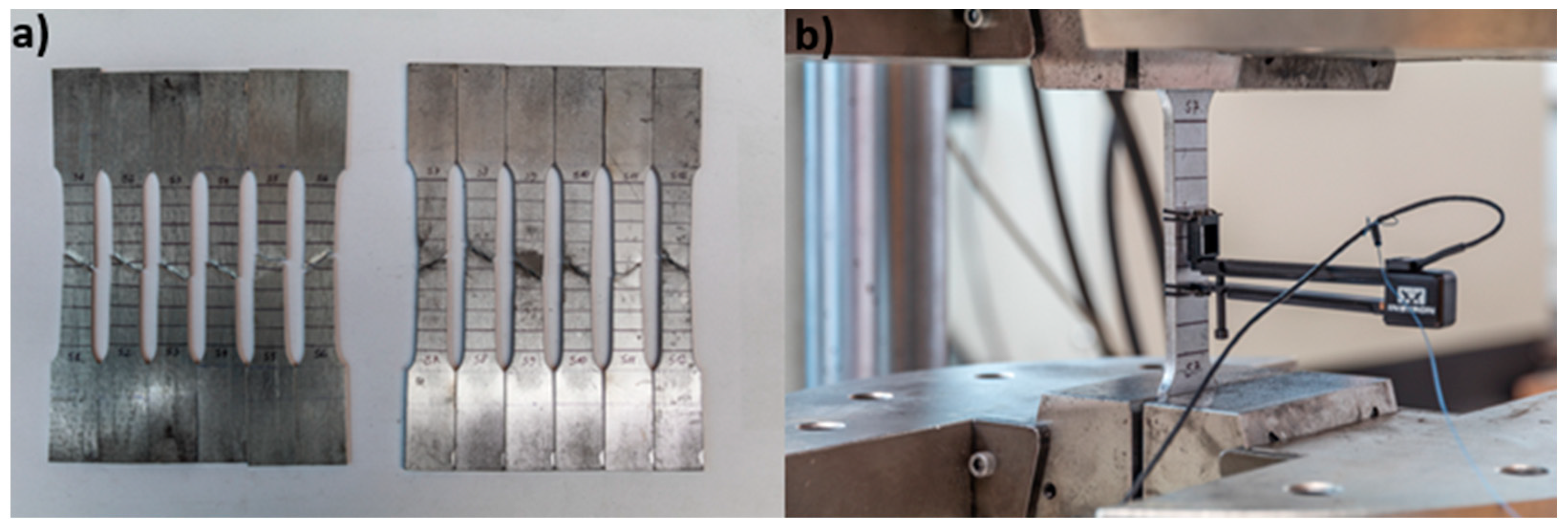

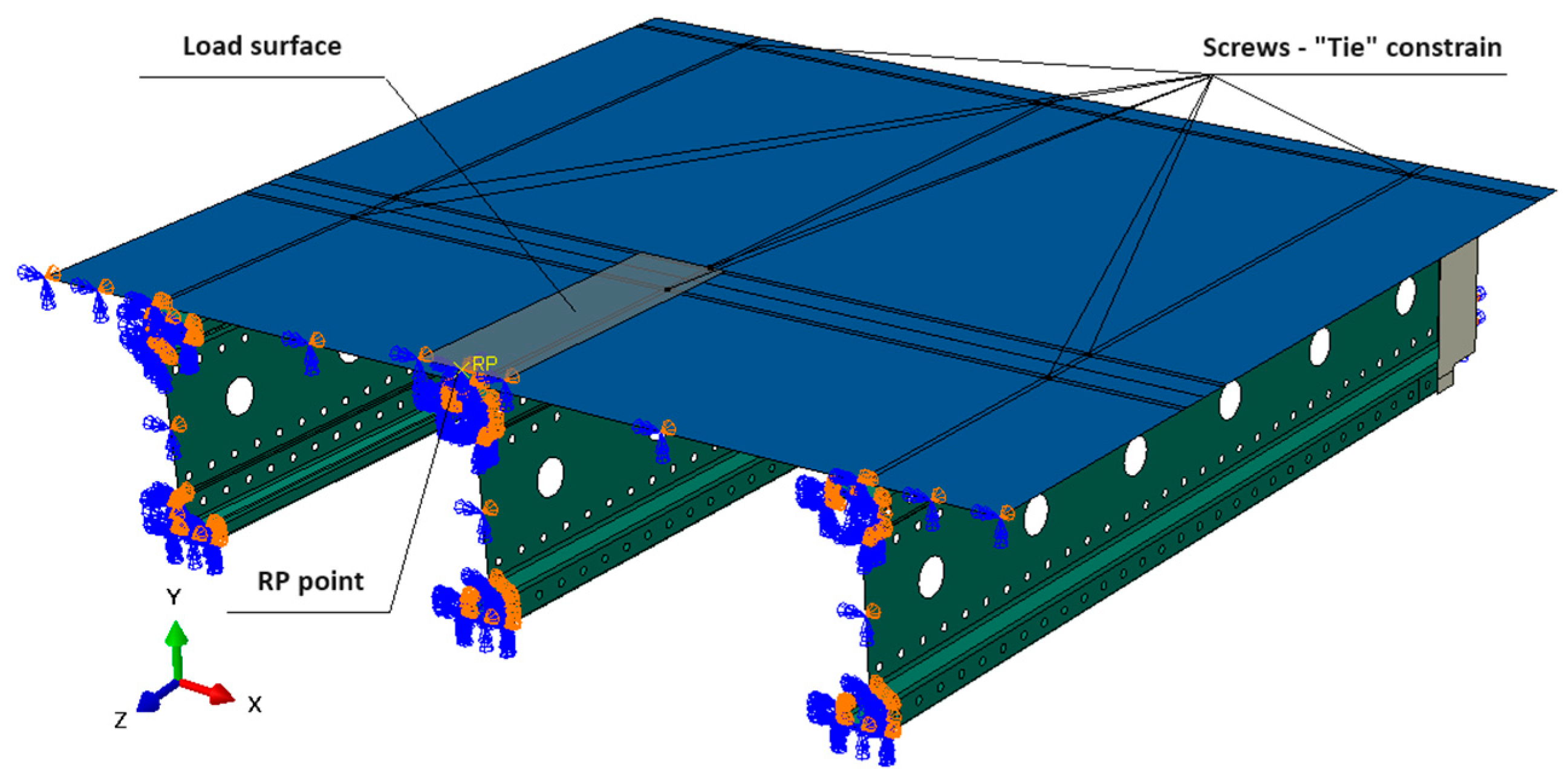
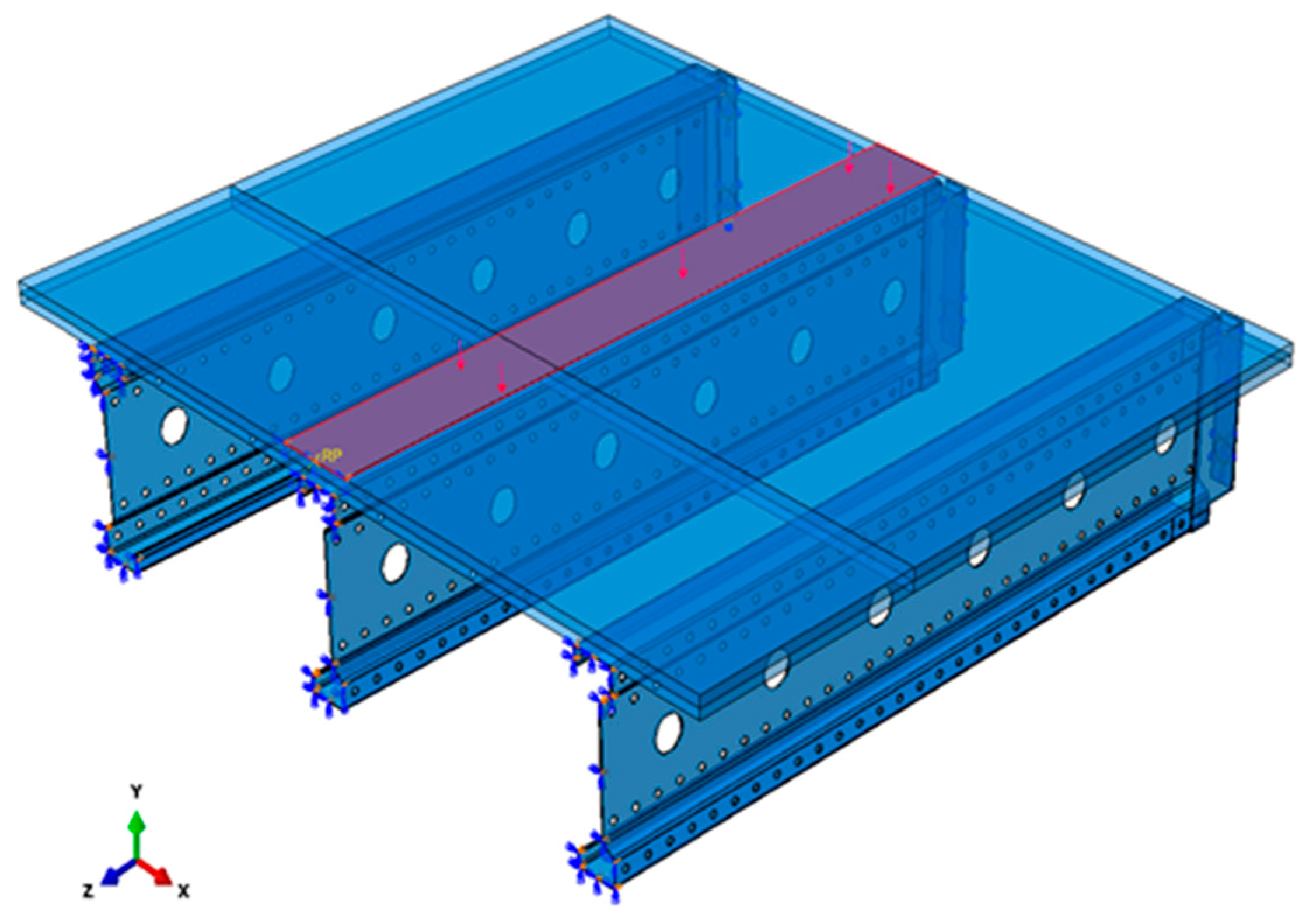









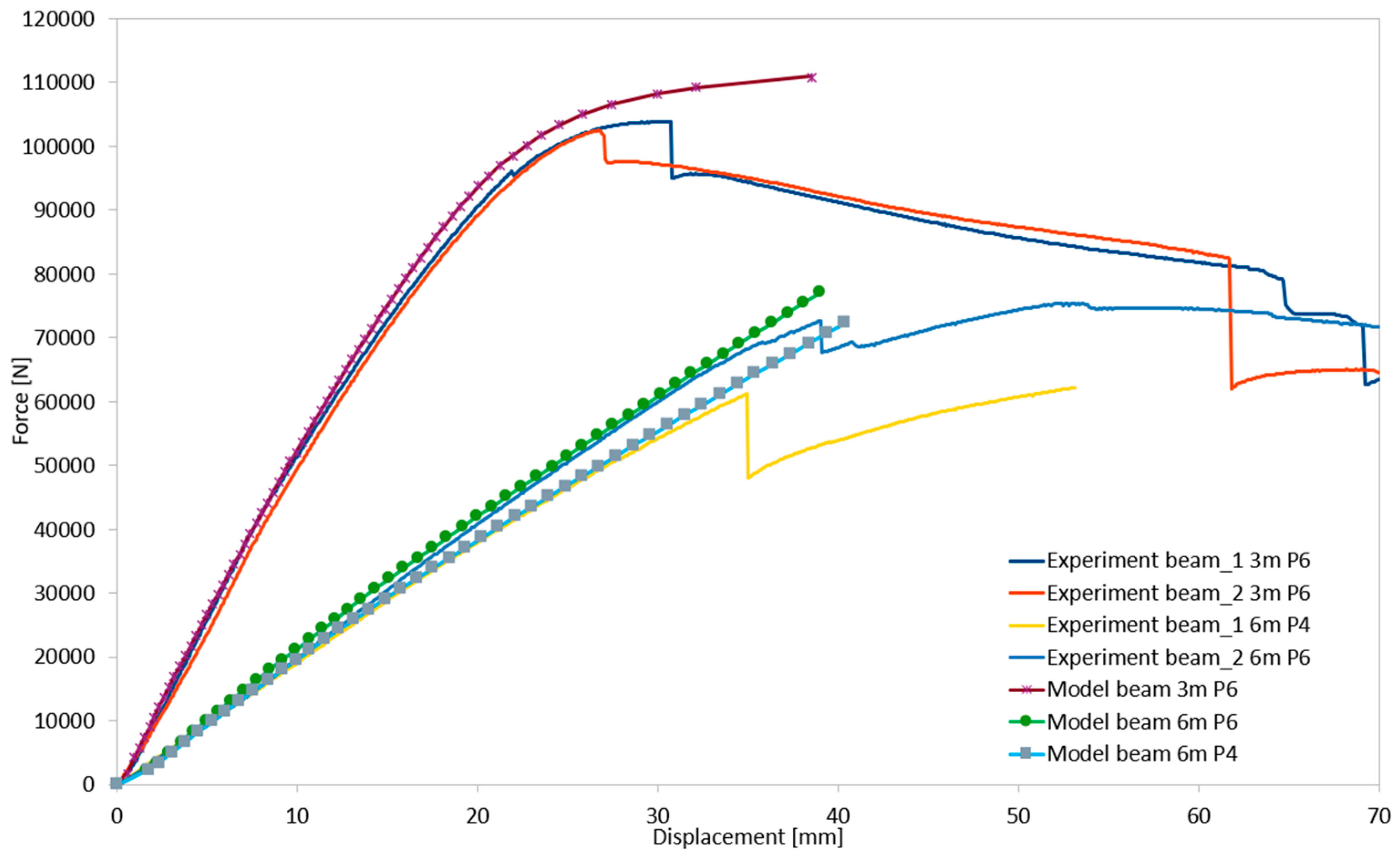









| Length of the Beam [m] | Load Taken over by the Left Beam [%] | Load Taken over by the Central Beam [%] | Load Taken over by the Right Beam [%] |
|---|---|---|---|
| 3.0 | 10.406 | 83.225 | 6.369 |
| 3.5 | 11.201 | 81.190 | 7.609 |
| 4.0 | 12.524 | 78.412 | 9.064 |
| 4.5 | 14.364 | 74.540 | 11.096 |
| 5.0 | 15.370 | 70.599 | 14.031 |
| 5.5 | 16.074 | 65.765 | 18.161 |
| 6.0 | 18.326 | 61.501 | 20.174 |
| Configuration | Max Load (Experiment) [kN] | Max Load (Simulation) [kN] | Difference [%] |
|---|---|---|---|
| 3 m (P6 deck) | 103.8 | 108.1 | 4.14 |
| 6 m (P6 deck) | 72.7 | 77.1 | 6.05 |
| 6 m (P4 deck) | 61.2 | 62.7 | 2.45 |
Disclaimer/Publisher’s Note: The statements, opinions and data contained in all publications are solely those of the individual author(s) and contributor(s) and not of MDPI and/or the editor(s). MDPI and/or the editor(s) disclaim responsibility for any injury to people or property resulting from any ideas, methods, instructions or products referred to in the content. |
© 2025 by the authors. Licensee MDPI, Basel, Switzerland. This article is an open access article distributed under the terms and conditions of the Creative Commons Attribution (CC BY) license (https://creativecommons.org/licenses/by/4.0/).
Share and Cite
Denisiewicz, A.; Socha, T.; Kula, K.; Błażejewski, W.; Wyjadłowski, M. Numerical Analysis of the Load-Bearing Capacity of a Thin-Walled Perforated Beam Cooperating with Chipboard Panels in a Structural System. Materials 2025, 18, 2208. https://doi.org/10.3390/ma18102208
Denisiewicz A, Socha T, Kula K, Błażejewski W, Wyjadłowski M. Numerical Analysis of the Load-Bearing Capacity of a Thin-Walled Perforated Beam Cooperating with Chipboard Panels in a Structural System. Materials. 2025; 18(10):2208. https://doi.org/10.3390/ma18102208
Chicago/Turabian StyleDenisiewicz, Arkadiusz, Tomasz Socha, Krzysztof Kula, Wojciech Błażejewski, and Marek Wyjadłowski. 2025. "Numerical Analysis of the Load-Bearing Capacity of a Thin-Walled Perforated Beam Cooperating with Chipboard Panels in a Structural System" Materials 18, no. 10: 2208. https://doi.org/10.3390/ma18102208
APA StyleDenisiewicz, A., Socha, T., Kula, K., Błażejewski, W., & Wyjadłowski, M. (2025). Numerical Analysis of the Load-Bearing Capacity of a Thin-Walled Perforated Beam Cooperating with Chipboard Panels in a Structural System. Materials, 18(10), 2208. https://doi.org/10.3390/ma18102208








